

 中文摘要:
中文摘要:
目的 了解血液系统恶性肿瘤在行异基因造血干细胞移植(allo-HSCT)后以多浆膜腔积液为主要表现的慢性移植物抗宿主病(cGVHD)患者的临床特点.方法 分析2003年6月至2013年7月在北京大学第一医院血液科行allo-HSCT的323例患者中发生cGVHD的情况,对其中合并多浆膜腔积液病例的临床特点和疗效进行分析.结果 对294例行allo-HSCT后存活超过100 d患者的cGVHD和严重程度进行评价,90例(30.6%)发生cGVHD,其中广泛型cGVHD 25例(8.5%).在所有发生cGVHD患者中,4例合并中、大量多浆膜腔积液,占全部发生cGVHD病例的4.44%,均为广泛型cGVHD,其积液性质为渗出液或介于渗出液与漏出液之间.应用糖皮质激素、免疫抑制剂等治疗有效,但易反复发作.结论 多浆膜腔积液是cGVHD较为少见的临床表现,其治疗效果较差.allo-HSCT后发生cGVHD且合并多浆膜腔积液应考虑为广泛型cGVHD,应给予积极治疗.
 英文摘要:
英文摘要:
Objective To analyze the clinical characteristics of polyserositis associated with chronic graft-versus-host disease (cGVHD) after allogeneic hematopoietic transplantation (allo-HSCT).Methods The occurrence rate and severity of cGVHD in 323 patients who received allo-HSCT in Peking University First Hospital from June 2003 to July 2013 were observed.Their clinical characteristics and therapeutic effect on polyserositis were analyzed as well.Results Of the 294 patients who survived for more than 100days after allo-HSCT,90 patients (30.6%) were diagnosed with cGVHD including extensive cGVHD in 25 patients (8.5%).Among the patients with cGVHD,4 patients (4.4%) developed moderate to large amount of polyserous effusions.All of these 4 patients had extensive cGVHD.The effusion was proved to be transudate or transudate-exudate.Immunosuppressive treatment was effective but unsustainable.Conclusions Polyserositis with large amount of effusion might be a rare manifestation of cGVHD and is refractory.When recurrent polyserous effusion presents with cGVHD after allo-HSCT,it should be considered as a manifestation of extensive cGVHD.Appropriate treatment should be given immediately.
 同期刊论文项目
同期刊论文项目
 同项目期刊论文
同项目期刊论文
 期刊信息
期刊信息
